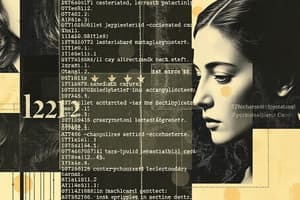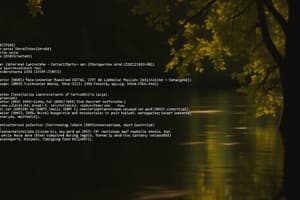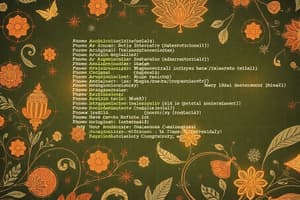Podcast
Questions and Answers
Flashcards
Algorithm
Algorithm
A finite set of instructions that, when followed, accomplishes a specific task.
Flowchart
Flowchart
A visual representation of the sequence of steps used to solve a problem.
Pseudocode
Pseudocode
A written description of an algorithm using a combination of plain English and programming-like constructs.
Syntax Errors
Syntax Errors
Signup and view all the flashcards
Logical Errors
Logical Errors
Signup and view all the flashcards
Conditional Branching
Conditional Branching
Signup and view all the flashcards
Loop
Loop
Signup and view all the flashcards
if Statement
if Statement
Signup and view all the flashcards
if-else Statement
if-else Statement
Signup and view all the flashcards
else if Ladder
else if Ladder
Signup and view all the flashcards
switch Statement
switch Statement
Signup and view all the flashcards
for Loop
for Loop
Signup and view all the flashcards
while Loop
while Loop
Signup and view all the flashcards
do-while Loop
do-while Loop
Signup and view all the flashcards
goto Statement
goto Statement
Signup and view all the flashcards
break Statement
break Statement
Signup and view all the flashcards
continue Statement
continue Statement
Signup and view all the flashcards
Array
Array
Signup and view all the flashcards
One-dimensional Array
One-dimensional Array
Signup and view all the flashcards
Two-dimensional Array
Two-dimensional Array
Signup and view all the flashcards
Linear Search
Linear Search
Signup and view all the flashcards
Binary Search
Binary Search
Signup and view all the flashcards
Study Notes
Programming for Problem Solving (GR24A1006) Lecture Material
- Course Overview: This course aims to introduce B.Tech first-year students to fundamental Computer Programming concepts using the GR-24 (Autonomous) syllabus.
- Course Objectives: The course aims to familiarize students with computer programming concepts and fundamental language skills methodically. The material is designed to meet the requirements of programming for problem-solving.
- Course Content: Lecture material covers topics like introduction to programming, algorithms, flowcharts, pseudocode, C programming fundamentals. The materials also include examples of adding two numbers, calculating an average, and finding the largest among a set of numbers. It also includes swapping two numbers, simulating an algorithm and flowchart for finding factorial of a number. The course further details flowchart symbols, different types of algorithms, examples, and limitations. Further, it covers topics like creating, compiling, and executing programs. The course also covers the structure of C programs with example programs that include documentation, link sections, global declaration and main function sections. The course defines and illustrates various data types in C with ranges and formats. It includes arithmetic operations on characters along with examples, logical, assignment, increment and decrement operators along with their syntax and flow charts, and example program usages. In addition the study program tackles conditional branching and loops, using for, while, do-while, go to, break, and continue statements, concepts of one-dimensional and two-dimensional arrays (declaration, initialisation, and manipulation) with example code, search and sort methods along with their algorithms and flowcharts, along with other types of files, operations and their syntax in detail.
Preface
- Authors: The lecture materials have been contributed and verified by faculty members from the Centre for Product Development and Services (CPDS) in the CSE, ECE, CSD, and CSM departments.
- Syllabus Adherence: The notes and examples conform to the GRIET GR-24 (Autonomous) syllabus.
Unit-I: Introduction to Programming
- Algorithms and Flowcharts: Algorithms are step-by-step procedures for solving a problem. Flowcharts are visual representations of algorithms using standardized symbols.
- Pseudocode: Pseudocode is an informal representation of an algorithm, using a mixture of natural language and programming-like constructs
- C Programming Language: Introduction to basic C programming, including variables, data types, operators, I/O.
Flowcharts
- Purpose: Flowcharts provide visual representation, communication, an overview of elements, their relationships and program logic.
- Limitations: Time consuming to create, difficulty in drawing complex logic, and lack of visual representation for programming constructs.
Flowchart Symbols
- Flow Lines: Connect symbols, showing the flow of logic.
- Terminal: Start and end points of the flowchart.
- Input/Output: Represents input and output operations.
- Processing: Represents calculations and data manipulation.
- Decision: Represents decision points (e.g., if-then-else statements).
- Connector: Joins flowchart branches.
- Sub Function: Represents user-defined functions.
UNIT-II Conditional Branching and Loops
- Conditional Statements: Usage of if, if-else, nested if-else, else if ladder and switch statements for decision-making in a program based on logical conditions
UNIT-II: Conditional Branching and Loops :
- Keywords and Expressions in Control Statements: Explains how to use keywords like
if,else if,else,while,do, andforin a program to control the flow through conditional statements.
UNIT-II: Loops and Arrays
- Iterations: Explains how
whileloop,do-whileloop, andforloop work using examples. - Jumping Statements: Describes and explains how
breakandcontinuework, with appropriate examples
Conditional Branching and Loops
- Flow Control: Explains structured programming concepts such as
if,if-else, andswitchstatements for making decisions and controlling program flow. Iterative statements such aswhile,do-while, andforare discussed in detail and illustrated with examples, and the concept of jumping statements likebreakandcontinueis introduced. The syntax and uses of each statement are illustrated with example code.
Studying That Suits You
Use AI to generate personalized quizzes and flashcards to suit your learning preferences.




